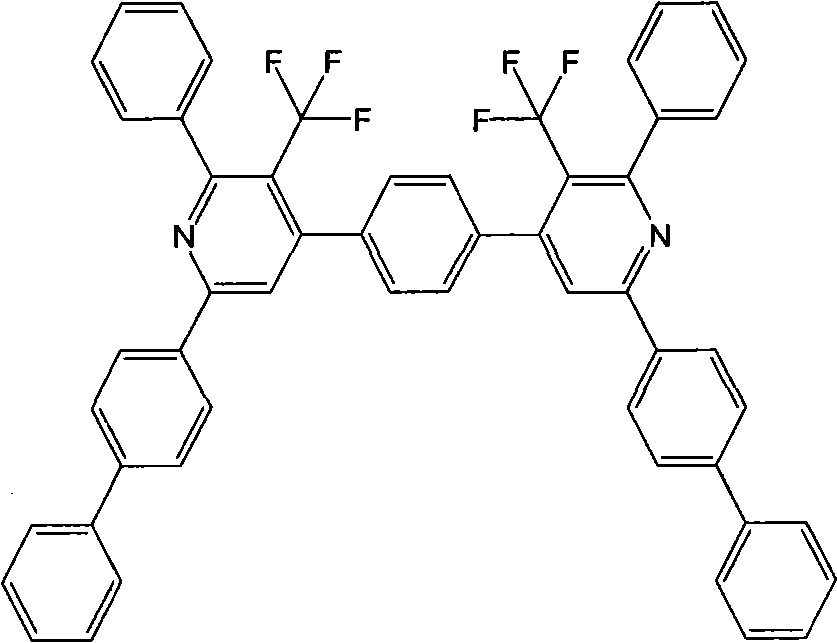Organic electron transport and/or hole blocking material and its synthesis method and use
A hole-blocking material and organic electron technology, applied in chemical instruments and methods, light-emitting materials, organic chemistry, etc., can solve the problems of changes in light-emitting properties, further improvement of stability, and poor device performance.
- Summary
- Abstract
- Description
- Claims
- Application Information
AI Technical Summary
Problems solved by technology
Method used
Image
Examples
Embodiment 11
[0056] Embodiment 1.1, the preparation of 4-bis(4-(2-phenyl-6-p-tolyl-3-trifluoromethylpyridine))benzene (BPTTPB)
[0057] The first step: take 2-bromo-1-(4-trifluoromethylphenyl)ethanone and pyridine with a molar ratio of 1 as raw materials, stir at room temperature for 11 hours, filter, and wash with a large amount of water to obtain the corresponding pyridine Bromide, the yield is about 90%;
[0058] The second step: under the condition of nitrogen protection, the product of the first step, terephthalaldehyde and p-methylacetophenone (molar ratio is 2:1:2) are added in the three-necked flask, and then an appropriate amount of glacial acetic acid is added and ammonium acetate, stirred vigorously, kept the temperature at 120°C to 140°C, refluxed for 24 hours, filtered out the product, and subjected to column chromatography or recrystallization to obtain the high-purity target product with a yield of about 50%.
[0059] m / z: 700.23 (100.0%), 701.23 (48.3%), 702.24 (11.2%), ...
Embodiment 21
[0069] Example 2.1, Preparation of 4-bis(4-(6-(4-biphenyl)-2-phenyl-3-trifluoromethylpyridine))benzene (BBPTPB)
[0070]
[0071] The first step: take 2-bromo-1-(4-trifluoromethylphenyl)ethanone with a molar ratio of 1, and pyridine as a raw material, stir at room temperature for 12 hours, filter, and wash with a large amount of water to obtain the corresponding pyridine Bromide, the yield is about 90%;
[0072] The second step: under the condition of nitrogen protection, the product of the first step, terephthalaldehyde and p-phenylacetophenone (molar ratio is 2:1:2) are added in the three-necked flask, and then an appropriate amount of glacial acetic acid is added and ammonium acetate, stirred vigorously, kept the temperature at 120°C to 140°C, refluxed for 24 hours, filtered out the product, and subjected to column chromatography or recrystallization to obtain the high-purity target product with a yield of about 55%.
[0073] m / z: 824.26 (100.0%), 825.27 (58.8%), 826.27...
Embodiment 34
[0074]Embodiment 3.4, the preparation of 4'-(1,4-phenylene) bis(2-phenyl-6-p-tolylpyridinecarbonitrile) (PBPTNN)
[0075] The first step: get 4-(2-bromoacetyl) benzonitrile with a molar ratio of 1, pyridine is a raw material, stir at room temperature for 10 hours, filter, and wash with a large amount of water to obtain the corresponding pyridinium bromide, with a yield of about 85%;
[0076] The second step: under the condition of nitrogen protection, the product of the first step, terephthalaldehyde and p-methylacetophenone (molar ratio is 2:1:2) are added in the three-necked flask, and then an appropriate amount of glacial acetic acid is added and ammonium acetate, stirred vigorously, kept the temperature at 120°C to 140°C, refluxed for 24 hours, filtered out the product, and subjected to column chromatography or recrystallization to obtain the high-purity target product with a yield of about 60%.
[0077] m / z: 614.25 (100.0%), 615.25 (47.9%), 616.25 (11.8%), 617.26 (1.7%...
PUM
| Property | Measurement | Unit |
|---|---|---|
| thickness | aaaaa | aaaaa |
| thickness | aaaaa | aaaaa |
| luminance | aaaaa | aaaaa |
Abstract
Description
Claims
Application Information
 Login to View More
Login to View More - R&D
- Intellectual Property
- Life Sciences
- Materials
- Tech Scout
- Unparalleled Data Quality
- Higher Quality Content
- 60% Fewer Hallucinations
Browse by: Latest US Patents, China's latest patents, Technical Efficacy Thesaurus, Application Domain, Technology Topic, Popular Technical Reports.
© 2025 PatSnap. All rights reserved.Legal|Privacy policy|Modern Slavery Act Transparency Statement|Sitemap|About US| Contact US: help@patsnap.com



